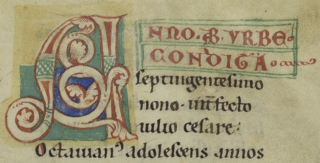Related Research Articles

The terms anno Domini (AD) and before Christ (BC) are used to label or number years in the Julian and Gregorian calendars. The term anno Domini is Medieval Latin and means "in the year of the Lord" but is often presented using "our Lord" instead of "the Lord", taken from the full original phrase "anno Domini nostri Jesu Christi", which translates to "in the year of our Lord Jesus Christ". The form "BC" is specific to English, and equivalent abbreviations are used in other languages: the Latin form, rarely used in English, is Ante Christum natum (ACN) or Ante Christum (AC).

Ab urbe condita, or anno urbis conditae, abbreviated as AUC or AVC, expresses a date in years since 753 BC, the traditional founding of Rome. It is an expression used in antiquity and by classical historians to refer to a given year in Ancient Rome. In reference to the traditional year of the foundation of Rome, the year 1 BC would be written AUC 753, whereas AD 1 would be AUC 754. The foundation of the Roman Empire in 27 BC would be AUC 727. The current year AD 2023 would be AUC 2776.
The Julian calendar is a solar calendar of 365 days in every year with an additional leap day every fourth year. The Julian calendar is still used in parts of the Eastern Orthodox Church and in parts of Oriental Orthodoxy as well as by the Amazigh people, whereas the Gregorian calendar is used in most parts of the world.

Year 457 (CDLVII) was a common year starting on Tuesday of the Julian calendar. At the time, it was known as the Year of the Consulship of Constantinus and Rufus. The denomination 457 for this year has been used since the early medieval period, when the Anno Domini calendar era became the prevalent method in Europe for naming years.
The Julian day is the continuous count of days since the beginning of the Julian period, and is used primarily by astronomers, and in software for easily calculating elapsed days between two events.

In mathematics, a multiplication table is a mathematical table used to define a multiplication operation for an algebraic system.
The Synod of Whitby was a Christian administrative gathering held in Northumbria in 664, wherein King Oswiu ruled that his kingdom would calculate Easter and observe the monastic tonsure according to the customs of Rome rather than the customs practiced by Irish monks at Iona and its satellite institutions. The synod was summoned at Hilda's double monastery of Streonshalh (Streanæshalch), later called Whitby Abbey.

Dionysius Exiguus was a 6th-century Eastern Roman monk born in Scythia Minor. He was a member of a community of Scythian monks concentrated in Tomis, the major city of Scythia Minor. Dionysius is best known as the inventor of Anno Domini (AD) dating, which is used to number the years of both the Gregorian calendar and the (Christianised) Julian calendar. Almost all churches adopted his computus for the dates of Easter.

As a moveable feast, the date of Easter is determined in each year through a calculation known as computus. Easter is celebrated on the first Sunday after the Paschal full moon, which is the first full moon on or after 21 March. Determining this date in advance requires a correlation between the lunar months and the solar year, while also accounting for the month, date, and weekday of the Julian or Gregorian calendar. The complexity of the algorithm arises because of the desire to associate the date of Easter with the date of the Jewish feast of Passover which, Christians believe, is when Jesus was crucified.
Dominical letters or Sunday letters are a method used to determine the day of the week for particular dates. When using this method, each year is assigned a letter depending on which day of the week the year starts.
Annianus of Alexandria was a monk and writer who flourished in Alexandria during the pontificate of Theophilus I around the beginning of the 5th century.

Inter gravissimas was a papal bull issued by Pope Gregory XIII on 24 February 1582. The document, written in Latin, reformed the Julian calendar. The reform came to be regarded as a new calendar in its own right and came to be called the Gregorian calendar, which is used in most countries today.
The Era of the Martyrs, also known as the Diocletian era, is a method of numbering years based on the reign of Roman Emperor Diocletian who instigated the last major persecution against Christians in the Empire. It was used by the Church of Alexandria beginning in the 4th century AD and it has been used by the Coptic Orthodox Church of Alexandria from the 5th century until the present. This era was used to number the year in Easter tables produced by the Church of Alexandria.
The Gallican Rite is a historical form of Christian liturgy and other ritual practices in Western Christianity. It is not a single liturgical rite but a Latin liturgical rites that developed within the Latin Church, which comprised the majority use of most of Western Christianity for the greater part of the 1st millennium AD. The rites first developed in the early centuries as the Syriac-Greek rites of Jerusalem and Antioch and were first translated into Latin in various parts of the Western Roman Empire Praetorian prefecture of Gaul. By the 5th century, it was well established in the Roman civil diocese of Gaul, which had a few early centers of Christianity in the south. Ireland is also known to have had a form of this Gallican Liturgy mixed with Celtic customs.
The controversy over the correct date for Easter began in Early Christianity as early as the 2nd century AD. Discussion and disagreement over the best method of computing the date of Easter Sunday has been ongoing ever since and remains unresolved. Different Christian denominations continue to celebrate Easter on different dates, with Eastern and Western Christian churches being a notable example.
Anatolius of Laodicea, also known as Anatolius of Alexandria, was a Syro-Egyptian saint and Bishop of Laodicea on the Mediterranean coast of Roman Syria in AD 268. He was not only one of the foremost scholars of his day in the physical sciences, as well as in Aristotelian and platonic philosophy, but also a renowned computist and teacher of the neoplatonic philosopher Iamblichus.
Augustalis was the first bishop of Toulon, according to some authorities. He was appointed in 441. He attended the Council of Orange that year, and the Council of Vaison the following. He is associated with the civitas of Arles by the Martyrologium Hieronymianum, which honors him on September 7. He is also named by the Martyrologium romanum on that day, with his location noted as in Gallia. An Augustalis, most likely this man, appears among a group of bishops addressed by Pope Leo I in letters dated 22 August 449 and 5 May 450, the latter of which addresses issues of jurisdiction between Arles and Vienne.
A laterculus was, in late antiquity or the early medieval period, an inscribed tile, stone or terracotta tablet used for publishing certain kinds of information in list or calendar form. The term thus came to be used for the content represented by such an inscription, most often a list, register, or table, regardless of the medium in which it was published. A list of soldiers in a Roman military unit, such as of those recruited or discharged in a given year, may be called a laterculus, an example of which is found in an inscription from Vindonissa. The equivalent Greek term is plinthos.

In algorithms, precomputation is the act of performing an initial computation before run time to generate a lookup table that can be used by an algorithm to avoid repeated computation each time it is executed. Precomputation is often used in algorithms that depend on the results of expensive computations that don't depend on the input of the algorithm. A trivial example of precomputation is the use of hardcoded mathematical constants, such as π and e, rather than computing their approximations to the necessary precision at run time.
Victorius may refer to:
References
- Victorii Aquitani Cursus Paschalis annorum DXXXII, ed. T. Mommsen, in: Chronica Minora Saec. IV, V, VI, VII vol. 1, pp. 667–735 (table 686–735), (1892, repr. Berlin 1961). Navigate through pages of online edition via arrows adjacent to "Blättern". Each line or year of the table continues across two pages (even-odd). Consuls are corrupt, often one or more years early (compare List of Roman consuls).
- David W. Maher and John F. Makowski. "Literary evidence for Roman arithmetic with fractions". Classical Philology96/4 (October 2001) 376–399.